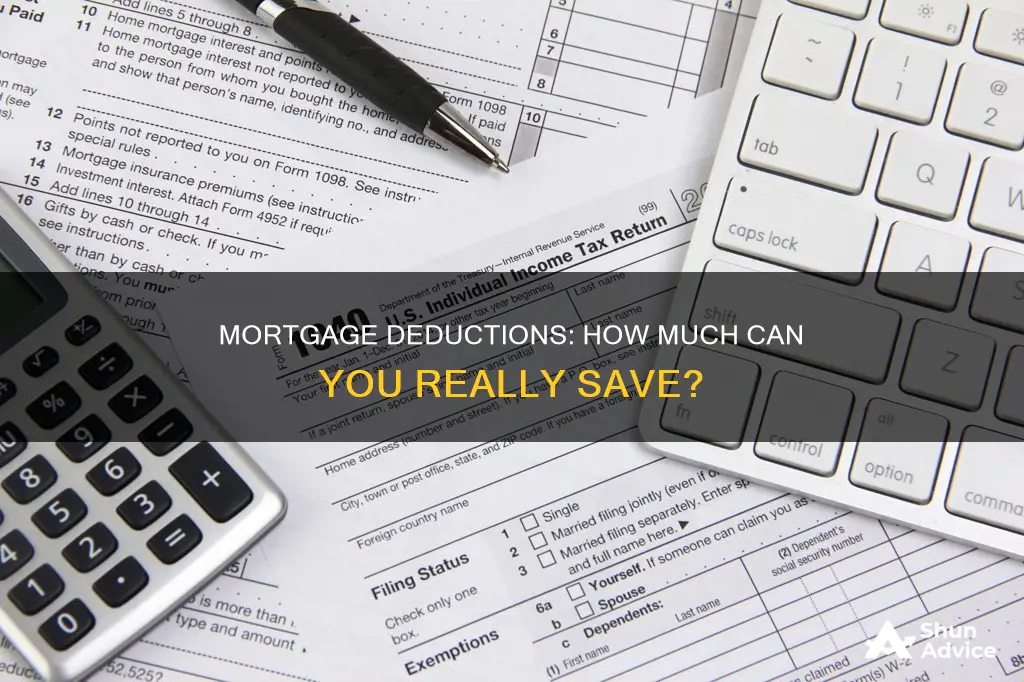
The home mortgage interest deduction (HMID) is a cherished tax break for American homeowners. It allows them to subtract mortgage interest from their taxable income, thus lowering the amount of tax they owe. However, the reality of the HMID doesn't always live up to the myth. Many homeowners don't receive a tax break at all from the deduction, and they must itemize their deductions to qualify for it. There is also a cap on how much mortgage interest can be deducted, which is currently $750,000 for a single individual or married couple filing jointly, or $375,000 for married couples filing separately.
| Characteristics | Values |
|---|---|
| What is the mortgage interest deduction? | A tax incentive for homeowners. |
| Who can avail of it? | Homeowners with a mortgage. |
| What can be deducted? | Mortgage interest, points, late payment charges, and penalties for paying off the mortgage early. |
| What is the maximum amount of debt eligible for the deduction? | USD 750,000 for mortgages obtained after Dec. 15, 2017; USD 1 million for mortgages obtained before Dec. 16, 2017. |
| Who can deduct the maximum amount? | Single individuals or married couples filing jointly. |
| What is the limit for married couples filing separately? | USD 375,000 for mortgages obtained after Dec. 15, 2017; USD 500,000 for mortgages obtained before Dec. 16, 2017. |
| What is the standard deduction for single taxpayers or married couples filing separately? | USD 14,600 for the 2024 tax year; USD 15,000 for the 2025 tax year. |
| What is the standard deduction for heads of households? | USD 21,900 for the 2024 tax year; USD 22,500 for the 2025 tax year. |
| What is the standard deduction for married couples filing jointly? | USD 29,200 for the 2024 tax year; USD 30,000 for the 2025 tax year. |
| What is the benefit of the deduction? | It allows homeowners to subtract mortgage interest from their taxable income, lowering the amount of tax they owe. |
| What is the difference between a deduction and a tax credit? | A credit reduces the tax you owe, whereas a deduction reduces your amount of taxable income. |
What You'll Learn

Itemizing deductions
To claim the mortgage interest deduction, homeowners must itemize their deductions by filing a Schedule A with their Form 1040. They will need a Form 1098 from their mortgage lender or servicer, which details the amount of mortgage interest and points paid during the year. This form is typically sent at the beginning of the year when taxes are due. If a homeowner doesn't receive it by mid-February, they should contact their lender.
It's important to note that not all homeowners benefit from itemizing deductions. Many homeowners don't have enough itemized deductions, even when including mortgage interest, to outweigh the standard deduction. The standard deduction for the 2024 tax year is $14,600 for single taxpayers or those married filing separately, $21,900 for heads of households, and $29,200 for married couples filing jointly. In 2025, these amounts will increase to $15,000, $22,500, and $30,000, respectively. Taxpayers who don't have itemized deductions that exceed the standard deduction amounts may not derive any tax benefit from paying interest on their mortgages.
The mortgage interest deduction also has limits on how much interest can be deducted. For mortgages obtained after December 15, 2017, the limit is the interest paid on the first $750,000 of mortgage debt for a primary residence or second home. If married individuals file separately, the limit is $375,000. For mortgages obtained before December 16, 2017, the limit is $1 million for married filing jointly or $500,000 for single or married filing separately.
Homeowners should also be aware that mortgage interest is not the only expense they will incur when purchasing a home. While some expenses like homeowners insurance, mortgage insurance premiums, and closing costs may seem deductible, they do not qualify as deductible mortgage interest. On the other hand, points, which are considered prepaid interest, can be deducted. Homeowners can choose to deduct points gradually over the life of the mortgage or all at once if they meet certain requirements.
Late Mortgage Payment: 30-Day Delay, Big Trouble?
You may want to see also

Tax breaks
The home mortgage interest deduction (HMID) is one of the most popular American tax breaks. It allows homeowners to subtract mortgage interest from their taxable income, thereby lowering the amount of tax they owe. However, it is also one of the most misunderstood aspects of homeownership. Many prospective homeowners are sold on the benefits before they even examine the math.
The reality is that the overwhelming majority of homeowners receive no tax break at all from the mortgage interest tax deduction. They must itemize their deductions when determining their income tax liability to qualify for the deduction and claim it. Itemizing provides an opportunity to account for specific expenses, including mortgage interest, property taxes, and partial medical expenses.
There is also a cap on how much of your mortgage interest can be deducted. The limit is the mortgage interest paid on the first $750,000 of indebtedness for a single individual or married couple filing jointly, or $375,000 if married and filing separately. A slightly higher limit exists for indebtedness incurred before December 16, 2017: $1,000,000 for married filing jointly or $500,000 for single or married filing separately.
There are other ways to benefit from tax breaks. For instance, if you get a nontaxable housing allowance from the military or through the ministry, you can still deduct your home mortgage interest. Additionally, if you sell your home, you can deduct any interest you paid before selling it. If you bought the house before December 16, 2017, you can deduct the interest you paid during the year on the first $1 million of the mortgage ($500,000 if married and filing separately).
Measuring Mortgage-Backed Security Prepayments: A Comprehensive Guide
You may want to see also

Home office deductions
Mortgage deductions can lead to significant savings for homeowners, and one of the critical aspects of these deductions is the ability to deduct expenses related to a home office. Here is an overview of what you should know about home office deductions:
Additionally, expenses related to the maintenance and upkeep of your home office can also be deducted. This includes a proportional amount of your utility bills, such as electricity, gas, and water, as well as repairs and improvements made specifically to your home office space. If you incur expenses for supplies and materials used in your home office, these can also be deductible. However, it's important to note that deductible expenses must be ordinary and necessary for your line of work.
There are two methods available for claiming home office deductions: the simplified method and the regular method. The simplified method allows for a deduction of $5 per square foot of your home office, up to a maximum of 300 square feet, resulting in a maximum deduction of $1,500. This method simplifies record-keeping and calculations. On the other hand, the regular method involves calculating and allocating actual expenses, including mortgage interest, property taxes, insurance, utilities, and repairs. This method may require more detailed record-keeping but can lead to a larger deduction if you have significant home office expenses.
To maximize your deductions, ensure you keep accurate records and consult with a tax professional to understand the specific rules and regulations that apply to your situation. It's important to note that home office deductions may not be available to everyone, and there are certain criteria that must be met to qualify. Additionally, the rules and regulations surrounding these deductions can change, so staying informed and seeking professional advice is always recommended.
Applying for a Mortgage: A Step-by-Step Guide
You may want to see also

Limits on deductions
The mortgage interest deduction is a tax incentive for homeowners. This itemized deduction allows homeowners to subtract mortgage interest from their taxable income, lowering the amount of tax they owe.
There are limits to the mortgage interest deduction. The limit is the mortgage interest paid on the first $750,000 of indebtedness for a single individual or married couple filing jointly, or $375,000 if you're married and filing separately. A slightly higher limit exists for indebtedness incurred before December 16, 2017: $1,000,000 for married filing jointly or $500,000 for single or married filing separately.
If you get a nontaxable housing allowance from the military or through the ministry, you can still deduct your home mortgage interest. A mortgage that you take out to "buy out" your ex-spouse's half of the house in a divorce also counts.
You don't have to use the home during the year. The house has to be collateral for the loan. If you rent out the second home, you have to be there for the longer of at least 14 days or more than 10% of the number of days you rented it out.
Mortgage interest is an itemized deduction, and you'll need to use Schedule A (Form 1040) to list your deductions. Other deductions that can be listed on Schedule A include medical and dental expenses, taxes paid, and donations to charity.
To fill out the information about the mortgage interest you paid during the tax year, you'll need a Form 1098 from your mortgage lender or mortgage servicer. This form details how much you paid in mortgage interest and points during the past year and is proof of your mortgage interest deduction.
Mortgage Surveys: Accurate or Fiction?
You may want to see also

Requirements for deductions
The mortgage interest deduction is one of the most popular American tax breaks. However, it is also one of the most misunderstood aspects of homeownership. Many prospective homeowners believe that every homeowner gets a tax break and that every dollar paid in mortgage interest results in a dollar-for-dollar reduction in income tax liability. However, this is not the case. In reality, the majority of homeowners do not receive any tax break at all from the mortgage interest tax deduction.
To qualify for the deduction, homeowners must itemize their deductions when determining their income tax liability. This means that they need to list out all of their specific expenses, including mortgage interest, property taxes, and partial medical expenses. For homeowners who do qualify for the deduction, it is important to note that it is not a tax credit. This means that they will not get a $1 tax break for every dollar spent on mortgage interest. Instead, the mortgage interest deduction reduces the amount of their total income that is subject to taxes based on their tax bracket.
There are also limits to how much of your mortgage interest can be deducted. For a single individual or married couple filing jointly, the limit is the mortgage interest paid on the first $750,000 of indebtedness. For those who are married filing separately, the limit is $375,000. A slightly higher limit exists for indebtedness that was incurred before December 16, 2017: $1,000,000 for married filing jointly or $500,000 for single or married filing separately. Additionally, the home must be collateral for the loan. If you rent out a second home, you must use it for at least 14 days or more than 10% of the number of days you rented it out.
To claim the mortgage interest deduction, you will need to fill out Form 1040 or 1040-SR and itemize your deductions on Schedule A (Form 1040). You will also need to receive a Form 1098 from your mortgage lender or servicer, which will detail how much you paid in mortgage interest and points during the past year. This form will be sent to you at the beginning of the year that your taxes are due.
Mortgages vs. Bonds: Understanding Key Differences in Finance
You may want to see also
Frequently asked questions
The mortgage interest deduction is a tax incentive for homeowners. This itemized deduction allows homeowners to subtract mortgage interest from their taxable income, lowering the amount of tax they owe.
The limit is the mortgage interest paid on the first $750,000 of indebtedness for a single individual or married couple filing jointly, or $375,000 if married and filing separately. A slightly higher limit exists for indebtedness incurred before December 16, 2017: $1,000,000 for married filing jointly or $500,000 for single or married filing separately.
If you bought your house before December 16, 2017, you can deduct the interest paid during the year on the first $1 million of the mortgage ($500,000 if married and filing separately).
Yes, you can still deduct any interest you paid before selling your house.
You can deduct a late payment charge if it wasn't for a specific service performed in connection with your mortgage loan. You may also be able to deduct the penalty for paying off your mortgage early as interest.







